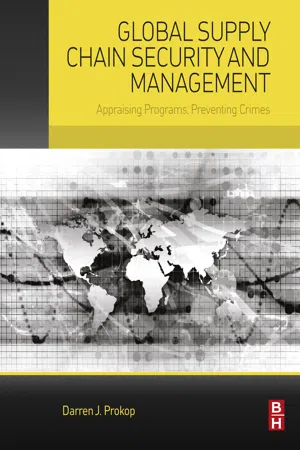
Global Supply Chain Security and Management
Appraising Programs, Preventing Crimes
- 200 pages
- English
- ePUB (mobile friendly)
- Available on iOS & Android
Global Supply Chain Security and Management
Appraising Programs, Preventing Crimes
About this book
Global Supply Chain Security and Management: Appraising Programs, Preventing Crimes examines the relationship between securing a supply chain and promoting more efficient worldwide trade. Historically, the primary goal of supply chain security was guarding against theft and damage. Today, supply chains are also on the frontlines in the fight against terrorism.This book showcases industry leaders and their best practices, also exploring how the government is both a policing organization and a supply chain partner. In addition, it covers the critical roles that various technologies play, focusing on how Big Data is collected and turned into knowledge.By using the tools provided, readers will gain a stronger understanding of the challenges and opportunities faced by any organization that imports or exports products.- Outlines the latest technologies being used to secure infrastructures- Leverages game theory to express the strategic interactions of government and business- Covers the latest U.S. regulations and provides analytical tools to help make sense of these regulations- Incorporates the latest theories and techniques of industrial organization, economics, and security
Frequently asked questions
- Essential is ideal for learners and professionals who enjoy exploring a wide range of subjects. Access the Essential Library with 800,000+ trusted titles and best-sellers across business, personal growth, and the humanities. Includes unlimited reading time and Standard Read Aloud voice.
- Complete: Perfect for advanced learners and researchers needing full, unrestricted access. Unlock 1.4M+ books across hundreds of subjects, including academic and specialized titles. The Complete Plan also includes advanced features like Premium Read Aloud and Research Assistant.
Please note we cannot support devices running on iOS 13 and Android 7 or earlier. Learn more about using the app.
Information
Introduction
Abstract
Keywords
Global Supply Chain Management
Definition
Logistics Management
Table of contents
- Cover image
- Title page
- Table of Contents
- Copyright
- Dedication
- Preface
- Chapter 1. Introduction
- Chapter 2. The Economics of Supply Chain Security
- Chapter 3. Threats to Supply Chains
- Chapter 4. The Role of Government
- Chapter 5. The Role of Information Technology
- Chapter 6. The Business and Government Interface
- Chapter 7. Trade Efficiency and Security: Are They a Trade-off?
- Chapter 8. Mitigating Risk and Measuring Success
- Chapter 9. The Future of Supply Chain Security
- Appendix: Some Useful Concepts and Analytical Tools
- Index